At the moment of writing, HNK Rijeka, led by their new manager, Zeljko Sopic, are at the top of 1. HNL, Croatia’s first division league. After a total of 26 games, they’ve accumulated 56 points, one more than the second-placed Hajduk Split and five more than Dinamo Zagreb, who currently sit in third. Things may change by the end of the season, but with the introduction of Sopić as their new manager, Rijeka have made leaps in the chase of their second-ever league trophy and their first since the triumph in 2016/17.
And for a Croatian league that has historically been dominated by a single club from the capital, which is not too dissimilar to the Bayern Munich situation in the Bundesliga, this is a huge achievement. So, in this tactical analysis, we’ll look at Željko Sopić, his philosophy and tactics and do a full analysis of his team to see the secret to their recent success.
Manager profile
Sopić has been in management for a number of years now; his early career was spent as assistant manager at both NK Lokomotiva Zagreb and NK Rudeš, where he eventually took over as the first-team coach in 2014. Following that stint, he even spent some time at Dinamo Zagreb, performing several roles from a youth academy coach to assistant manager and eventually caretaker manager for the senior team in 2016. His next couple of jobs took him abroad to Al-Ain FC and Sabah FK in the UAE and Azerbaijan before he settled back in Croatia in 2022/23 as HNK Gorica’s first-team coach and then, in August 2023, he took over HNK Rijeka for the 2023/24 season.
Currently, he’s leading the second-youngest squad in the league with an average age of 24.5 and doing so extremely well. Rijeka are a part of the big three teams in Croatia and are playing some of the most entertaining and effective football in 1. HNL, despite the league’s overall drop in quality this season. In 2023/24, Sopić has already led his team in a total of 30 games at the moment of writing, registering 18 victories, eight draws and only four defeats. In 2024 alone, Rijeka has so far won seven out of eight games in total, losing only one to their direct rivals for the title, Dinamo.
But the 49-year-old coach is a great man-manager, too; he’s created a team that follows him and trusts his judgement and fiery personality, which is definitely a big part of their recent success. The other side of the coin, however, are the tactics. So, let’s dive into the analysis next.
In-possession tactical analysis
Build-up phase tactics
In 2023/24 so far, Rijeka have mostly relied on the balanced approach of the 4-1-4-1 structure (56% of the games in 1. HNL), with Sopić occasionally opting for a 4-2-3-1 in specific situations. The former formation, however, is somewhat of a staple of the new coach, and Rijeka will generally field a single defensive midfielder with interiors around and just above him. They are also a team that doesn’t depend, nor do they insist on long spells of possession, ranking fourth in the league among the best possession sides with an average of 51.1%.
They are also the team with the fourth-most passes (6th per 90). They will generally like to be the protagonists and the aggressor, but not necessarily through extended periods in possession of the ball. Instead, we’ll see them use their dynamism and rotations to gain access to the wide areas to progress the play and attack the box.
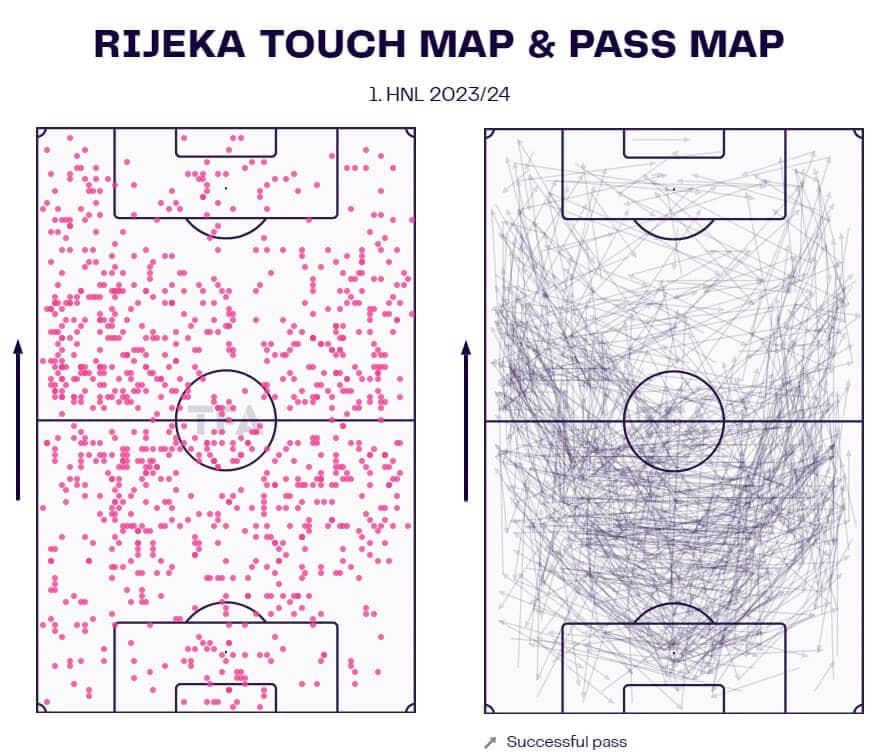
Looking at their touch and pass maps for 2023/24, we can see that wide focus quite clearly; Rijeka will recycle the ball if needed in the first phase, but they will also be fairly quick to verticalise the play once there’s an avenue to do so, as indicated by the medium-to-long-pass sequences into the full-back and winger zones from the defence and midfield respectively. This doesn’t come as a big surprise since Rijeka have the third-lowest passing rate with 13.1 passes per minute of ball possession and the fourth-most long passes (most among the big three) in the league.
The vertical approach seems to work, however, largely because the team’s main profiles benefit immensely from it—more on that in the later parts of this tactical analysis. Staying in the build-up phase, however, their progression graph, which we will see next, adds more proof to our initial wide-area-focused thesis.
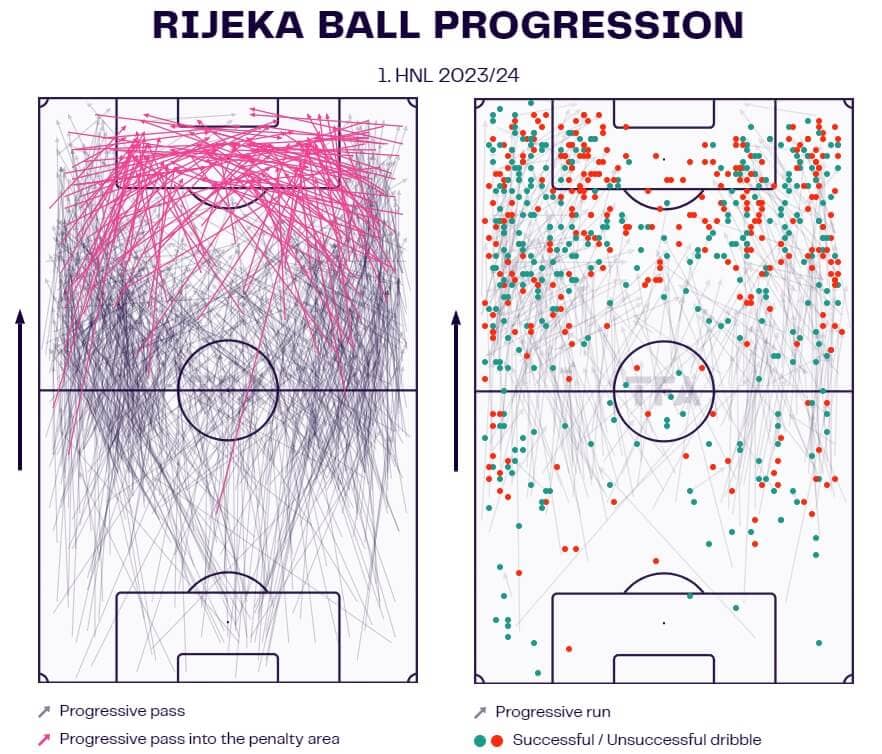
Once again, most of Rijeka’s progression is indeed centred around accessing their wide zones as quickly and efficiently as possible. If progression is happening from the first phase, it will generally be a long switch or a ball over the top. Alternatively, they will use progressive carries from the half-spaces to bypass the opposition’s first line of press and link up with the dropping midfielders or inverting full-backs.
They do rank fifth in progressive passes in the league but third in progressive runs, which tells us they do have a preference in that regard. Of course, since they pass less and put less focus on possession than the other two members of the big three, their progressive numbers are also subsequently lower. Nonetheless, Sopić has managed to introduce some clear tactics in the first phase to ensure smooth progression even in the face of a press.
The following sequences (A – B, 1 – 2) show us a distinct approach in the build-up phase Rijeka utilise to break the opposition’s first line of defence.
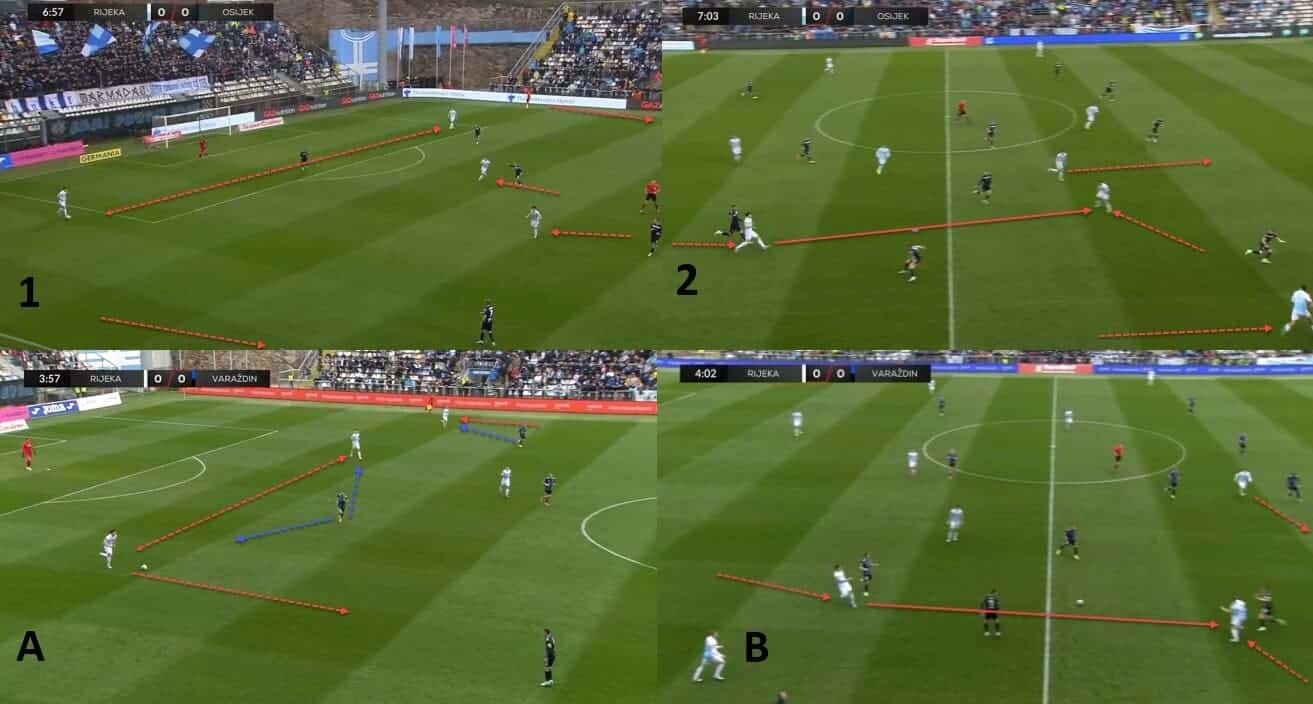
Their centre-backs aren’t necessarily the best ball players in the league, but the system will often position them very wide and will be set up in such a way that one of them (largely the RCB) can be ejected into midfield for a progressive run from the first line, as seen in both sequenced pictured.
The idea is relatively simple: either ensure positional or numerical superiority so the centre-backs can run with the ball and then link up with either the high interiors, the inverting full-back or the near-side winger. Since Rijeka do a lot of wide rotations, which we’ll touch upon shortly in the following sections of this tactical analysis, the centre-back will often have a different target in various different situations. That said, the onus on the wide zones remains here as well.
If the centre-backs can’t find the space to run into on their own, one of the full-backs can drop into the backline to create a back-three and force an overload or simply drag players from the opposition’s second line to create more space there for their own midfielders. Speaking of midfielders, two players that stand out in the first two phases are Veldin Hodža and Lindon Selahi.
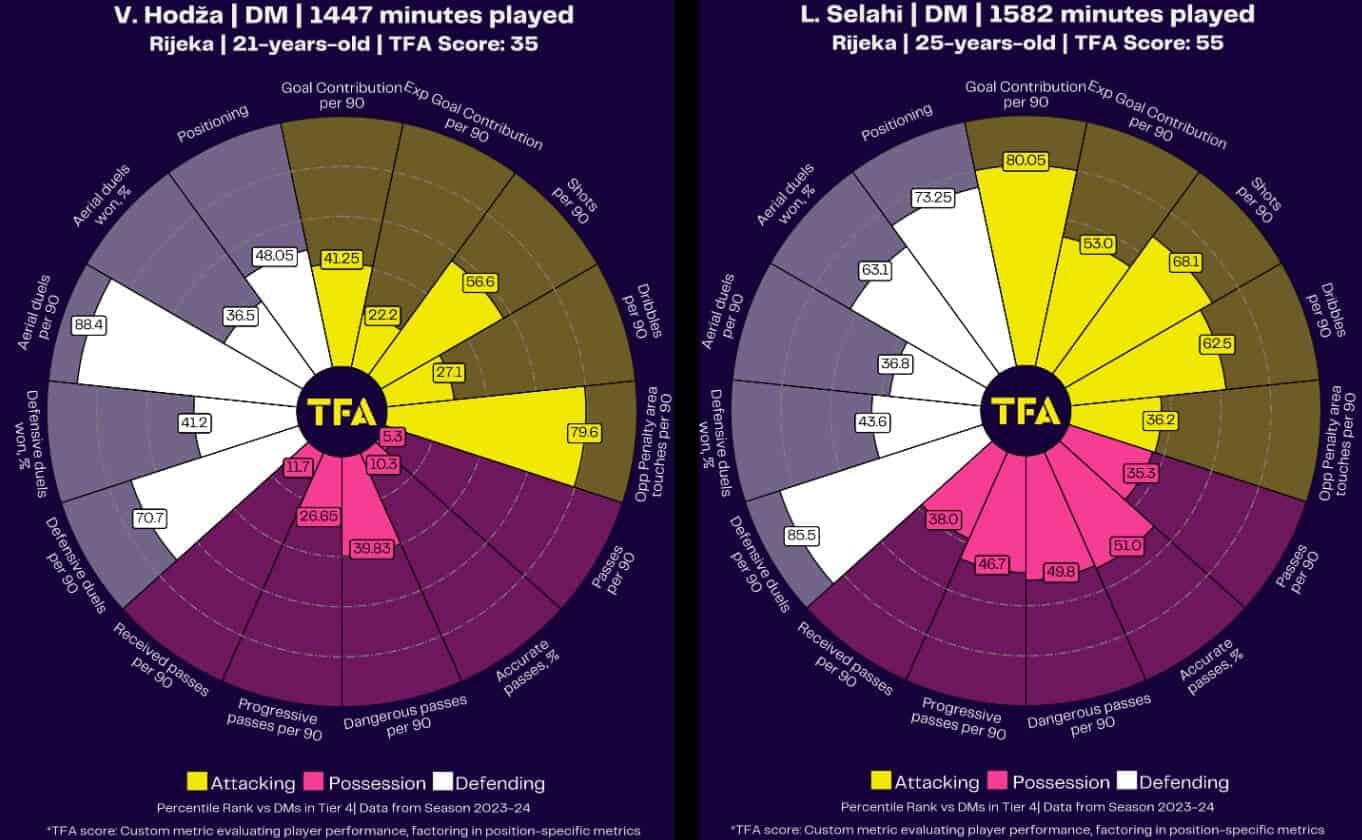
Both of them profile as defensive midfielders, but the former is often more of an interior who gets the licence to roam higher up, as seen in his latest venture when he scored a hat trick in a derby game against NK Osijek. The numbers suggest Selahi is the most dangerous one in possession, but it’s Hodža who registers a lot of touches in the opposition’s penalty area per 90 for a midfielder who profiles as a defensive one.
Still, these two players have a lot of influence on getting the ball into the right areas and ensuring Rijeka’s play is ticking smoothly. This is especially true for someone like Selahi, whose presence is that of a utility player and a glue for the rest of the squad in that pivotal position in the central areas. Again, the pure numbers don’t necessarily top many categories in a league-wide context, but that is more due to the distinct style the team prefers than an indication of a lower-quality player.
Final third tactics
Rijeka, under Sopić, are a deadly team to face. In 2023/24, they’ve scored the most goals in the league with 52 from 47.19 xG and have done so with the most total and per 90 shots, even eclipsing the likes of Dinamo Zagreb and Hajduk Split. They are a team that will outscore most if not all, other teams in 1. HNL regularly. And this is where we come back to the wide area focus.
Rijeka arguably have some of the best isolation wingers in the league so it’s only natural their tactics aim to exploit their best qualities. As a team, they rank third in most 1v1s and dribbles (second if we look at per 90 stats), which is an indicator of the emphasis they put on such an approach. Their deadliest combinations and sequences are usually born from a wide ejection or a 1v1 isolation for one of the wingers who can attack space.
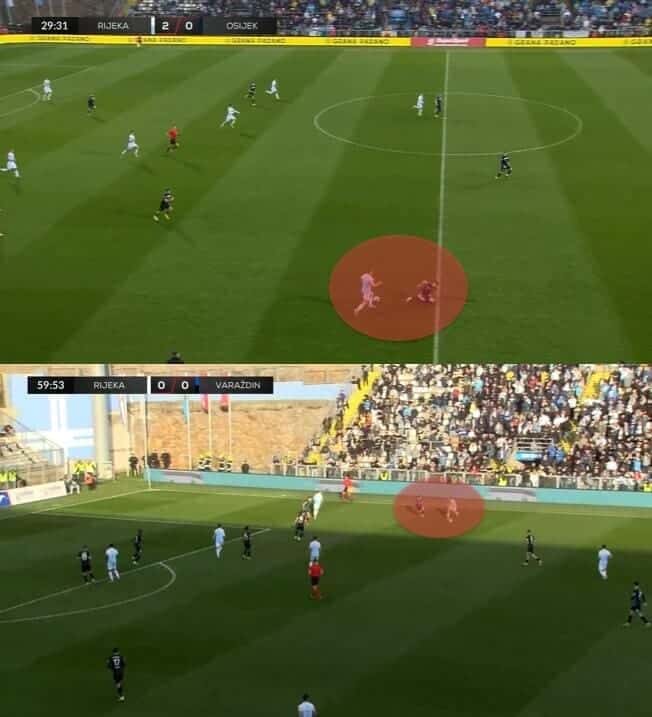
This last example shows a relatively generic couple of sequences that show Rijeka’s intent to create such scenarios as much as possible. This can be done in a more stable phase of open play possession or in transitional moments, as shown in the images. Generally, if Rijeka can access their wide men in open space, it’s curtains for the opposition. But actually creating those situations can be easier said than done when the other team knows the focus will be put there. Precisely for that reason, Sopić has implemented several tactics to outmanoeuvre the opponent and gain an advantage.
The fundamental principle is that of rotation since the focus is indeed on the wide areas. Naturally, the full-backs and wingers need to have a good relationship and understanding of their respective roles. Sometimes, that will mean the winger will invert to drag the marker away and open acres of space for the full-back to exploit. Other times, the full-back will invert to overload the opposition’s full-back who now suddenly has to make a choice between two players occupying his zone. Or the two will simply move in opposite directions to create more dilemmas for the defenders.
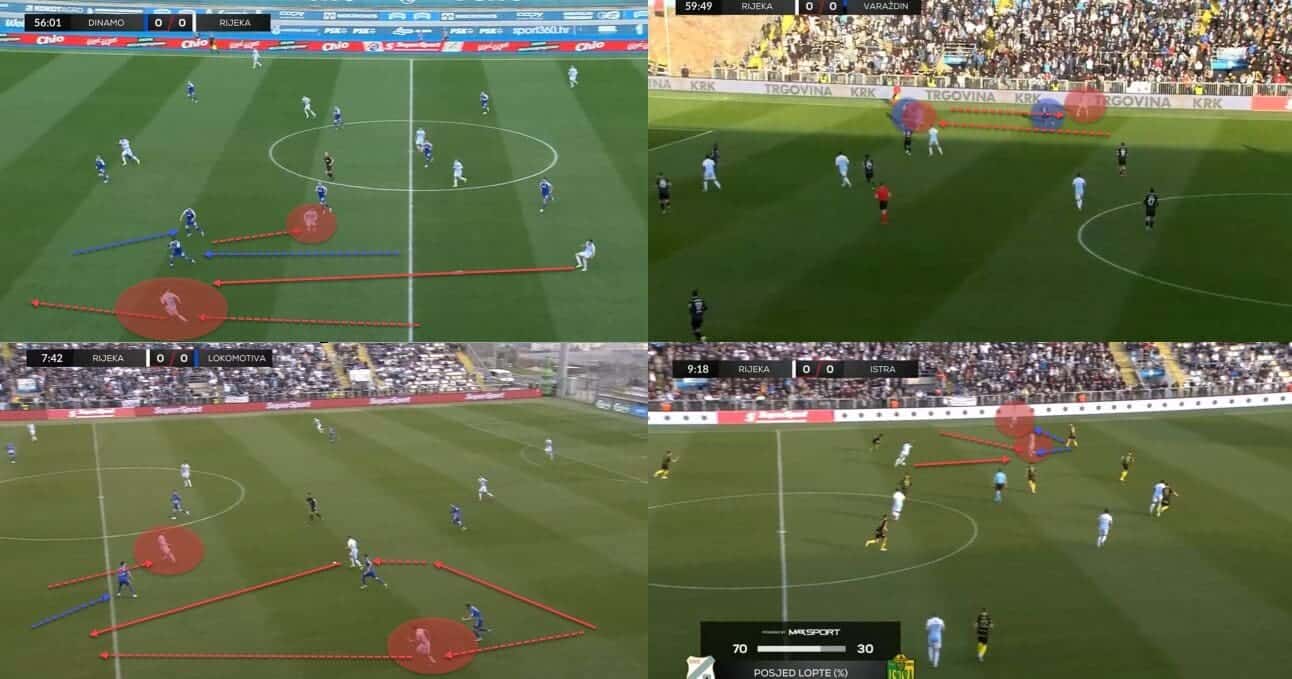
Again, the rotations are pretty simple but also effective precisely because of the decisional dilemmas they put on the defenders: do they follow their markers blindly and risk exposing space behind them? Do they maintain their positions not to compromise their zones but then risk having the attackers accessible in advantageous areas of the pitch? Rijeka do this exceptionally well and always with a single goal in mind: isolation.
The sequences in the previous image all created isolations or opened up space for the wide players to exploit. When you have enough quality in those areas and in those specific positions, such a system can only amplify their value. Looking at their attacking proficiency, it does seem to be working for now.
Rijeka are scoring in line with their expected goals value and are scoring from high-value positions in the box. Similarly, they are a team that can create from open play and set pieces, as well as get goal-scoring contributions from several different players, each of whom can produce moments of magic when the other is not having the best of days.
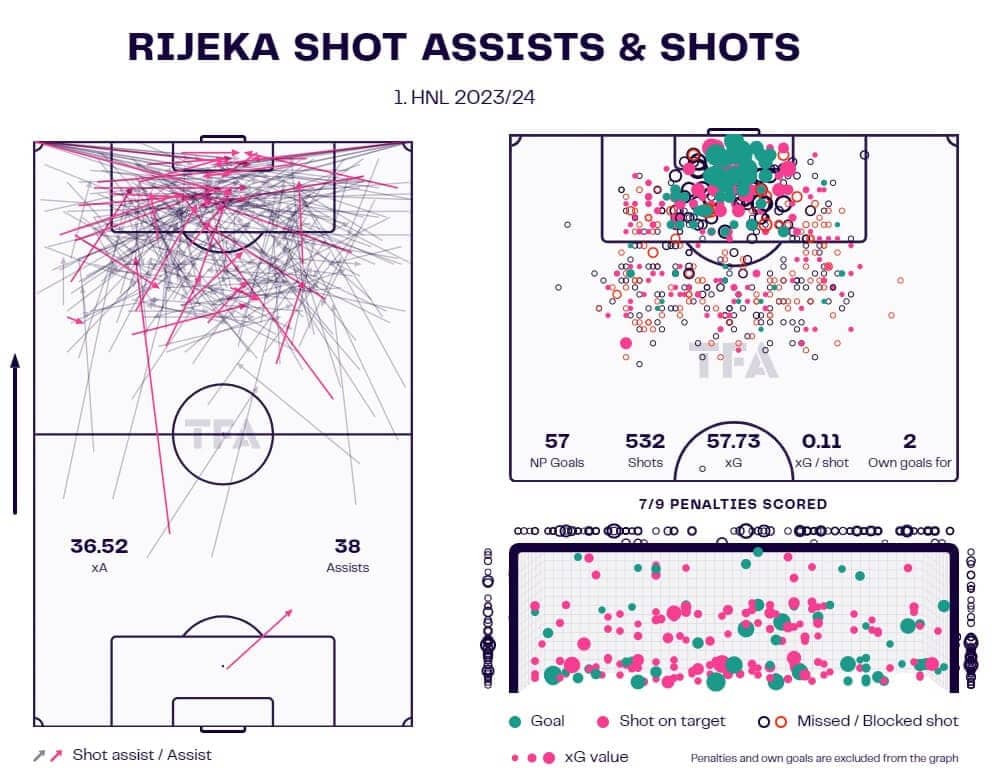
In that sense, Rijeka can win games against all sorts of opponents even when they’re not necessarily performing at an exceptionally high level; they simply have many difference-makers who flip a game on its head and contribute with something out of nothing. If someone like Toni Fruk doesn’t produce a goal when it’s a do-or-die situation, maybe Marko Pjaca will. If not Pjaca, then maybe Marco Pašalić will. And if not him, perhaps it will be Jorge Obregon or Franjo Ivanović. You get the point; none of them are necessarily consistent game-breakers, but they don’t have to be because someone will always come up with something at some point. That’s Rijeka’s secret.
They can succeed with players who won’t all win you games every week, but at least one will always shine with a ‘something out of nothing’ moment. Interestingly, however, for a team with such a clear focus on the wide areas, Rijeka are surprisingly bad at crossing the ball and hitting the right places.
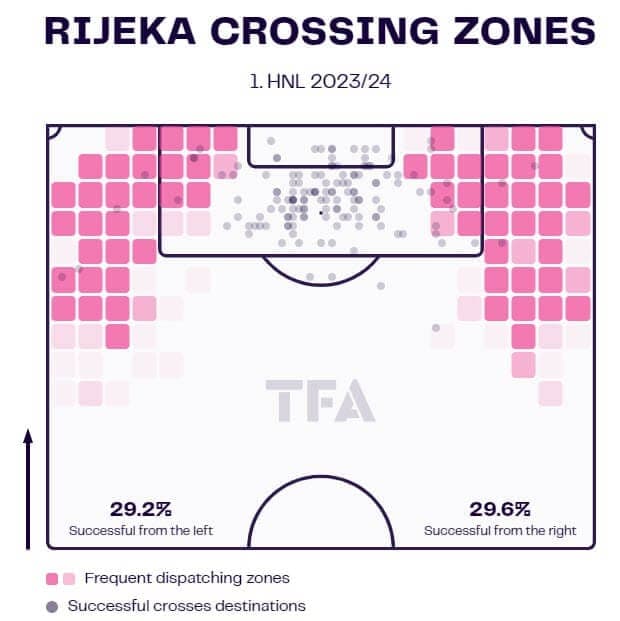
They rank sixth in the league for most crosses but have the second-worst accuracy with 28.9%. Similarly, very few of their crosses actually find their targets in the six-yard box, and they are once again the team with the second-worst success rate in the league. For a team with title aspirations and a clear preference for wide isolations, this could pose a problem.
That said, they still have enough firepower from both a creative and goal-scoring standpoint when it comes to wingers, and they’ve managed to thrive in spite of their crossing inefficiency. At the moment, both Pjaca and Pašalić seem to have differential quality on the flanks, and they come with slightly different skills.
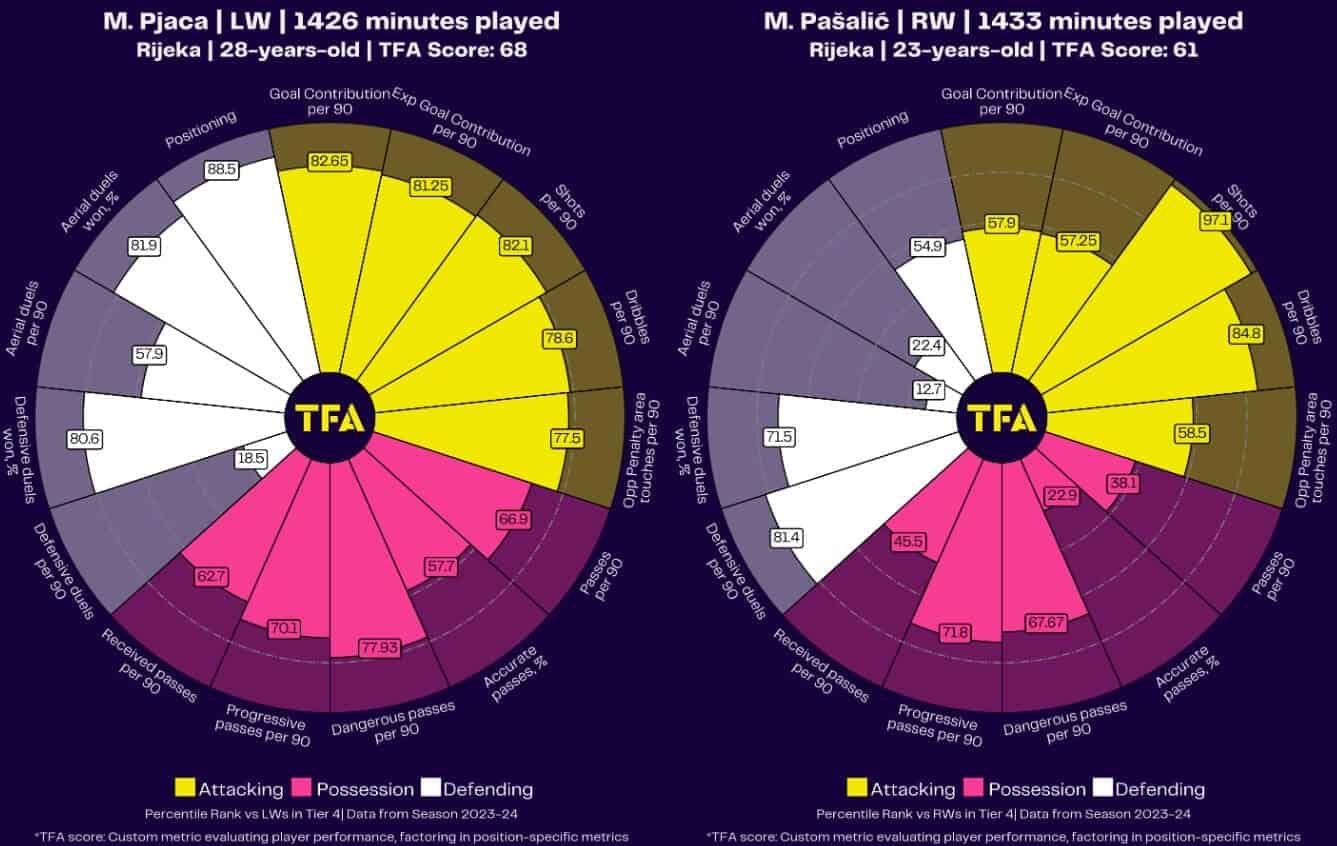
Both, however, have a high influence on Rijeka’s goal-scoring proficiency and seem to be key cogs in Sopić’s machine. But they are hardly the only ones. In fact, arguably the most firepower the current 1. HNL leaders have is found in the middle of the pitch and from attacking midfielders or interiors like Fruk and Niko Janković, the latter also occupying the wide areas at times.
When it comes to creating chances, goals, and shots, whether from passing or shooting, no one on the team is as effective as these two players. Even more impressive is that we’re talking about 23-year-olds and 22-year-olds, respectively. A quick glance at their statistical profiles says enough, as they top almost every single attacking metric in our database.
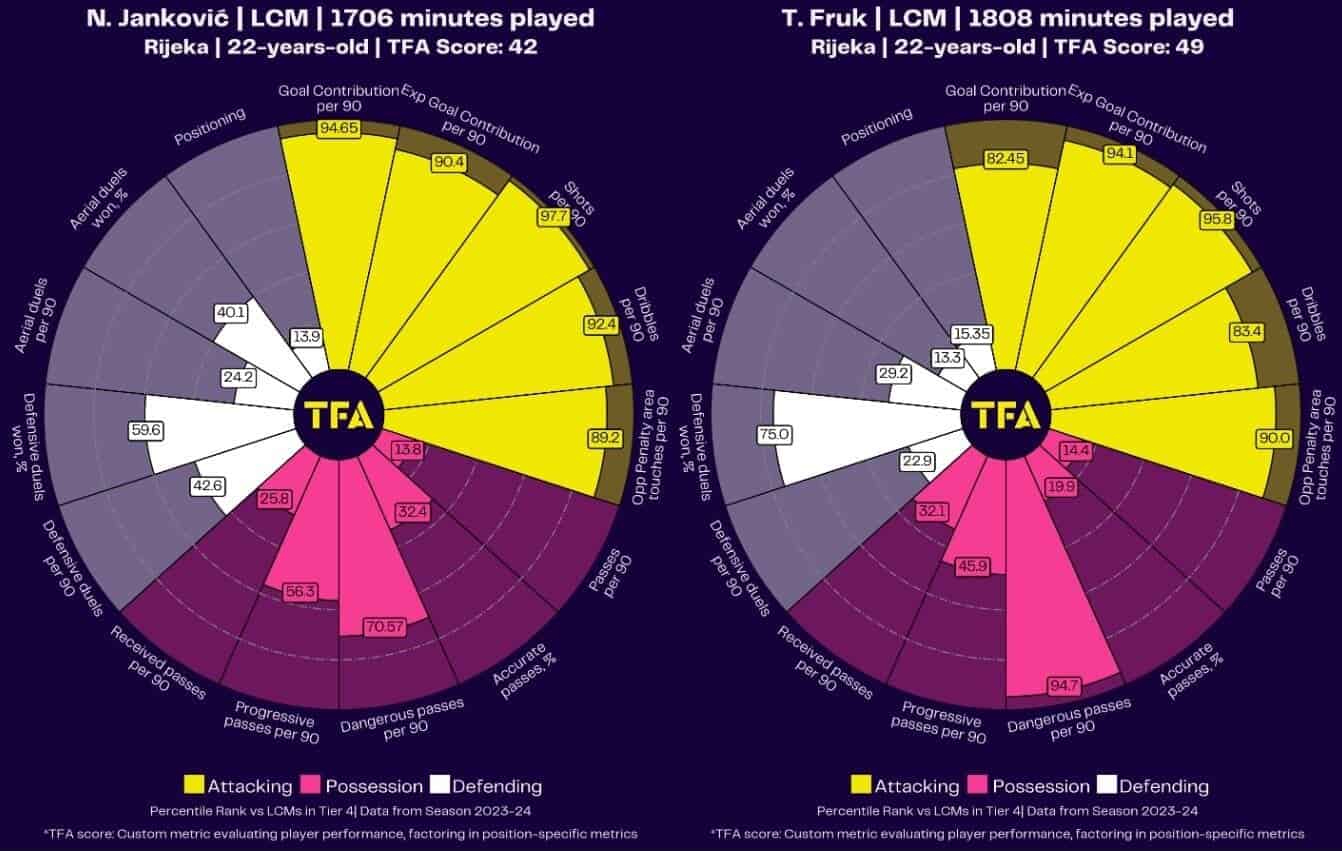
Interestingly, however, it’s also what Rijeka do out of possession that often contributes to their in-possession prowess. Let’s explore that next.
Out-of-possession tactical analysis
At the moment of writing, HNK Rijeka have the second-best defensive record in 1. HNL with 20 goals conceded, only worse than Hajduk Split’s 14. Similarly, their opponents have only managed to accumulate a total of 27.7 xGA, meaning they’ve so far managed to concede less than what you’d expect from the quality of the opposition’s chances in front of their goal. But if we look a bit deeper into the statistical analysis, we can see that Rijeka are exceptional at keeping the opposition at bay.
Not only do they have the third-most shots blocked in the league, but have also allowed the second-least shots to the opposition, solidifying themselves as one of the most defensively secure teams in the Croatian first division.
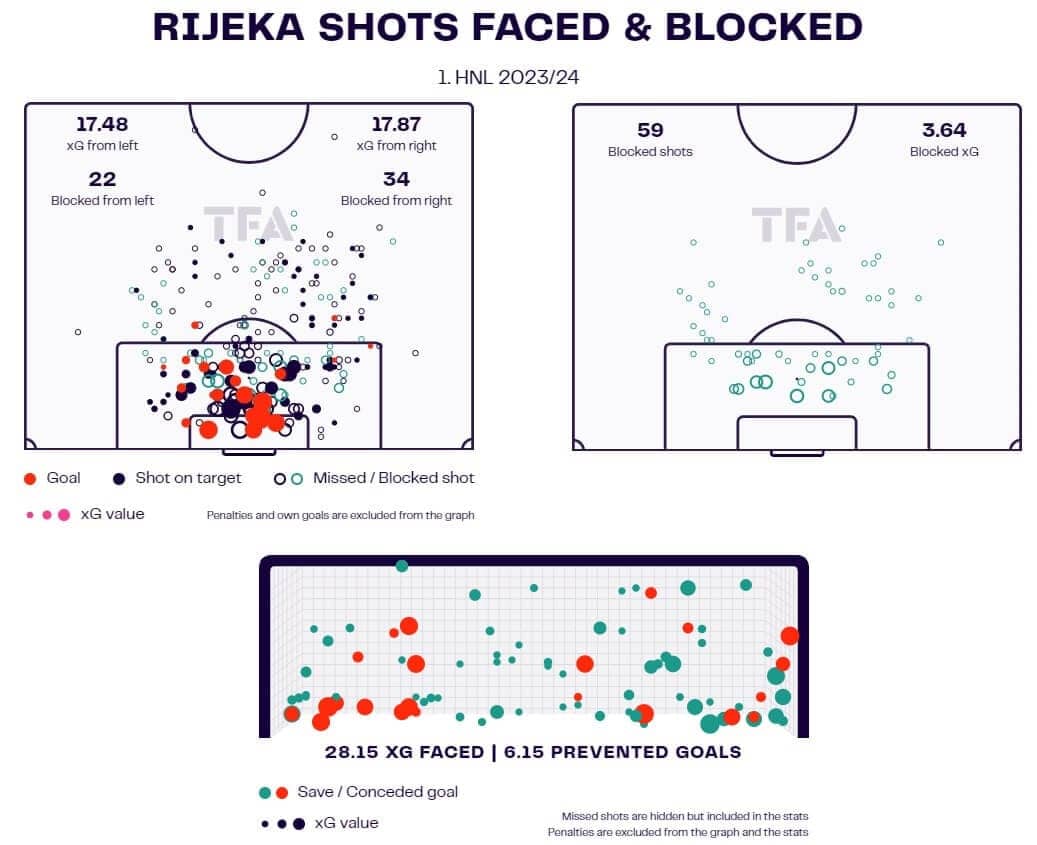
It’s quite interesting to note that they have prevented around 9.75 goals just through their blocks and goalkeeper intervention. Regarding defending in zones, Rijeka seem equally proficient at both the left and the right, but low-driven shots to the goalkeeper’s right side pose a significant problem to the current 1. HNL leaders. That being said, most of those goals did come from higher xG situations, making them more clear-cut than others. While this might simply mean Rijeka have allowed the opposition to get into an excellent chance to score those low-driven shots, it’s also unlikely this is purely a coincidence either.
Still, even with that taken into account, they do seem like solid box defenders, both individually and collectively, and know how to defend in a low-to-mid block. Generally speaking, Sopić doesn’t have them pressing high relentlessly and will instead emphasise intensity in the middle third of the pitch, focusing on collapsing and then verticalising very quickly.

We can see such an example here. Immediately upon recovering the ball in the middle third, Rijeka activate several runners who attack space and ultimately penetrate the box. This is another aspect of this highly vertical play that seems to be yielding good results: always having enough bodies inside the opposition’s penalty area. While not foolproof, this principle can mask the flaw they have with hitting targets in the six-yard box, as there are always more than just one to aim for, and the chances of converting are higher.
Finally, if we examine Rijeka’s defensive territory and high regains through a statistical lens, we can see the numbers confirm our initial thesis of them being a more mid-block-oriented team than necessarily an aggressively high-press one. As previously mentioned, the intensity comes in collapsing in the middle third, even though Rijeka is no stranger to turnovers in possession and creating or even scoring directly through them.
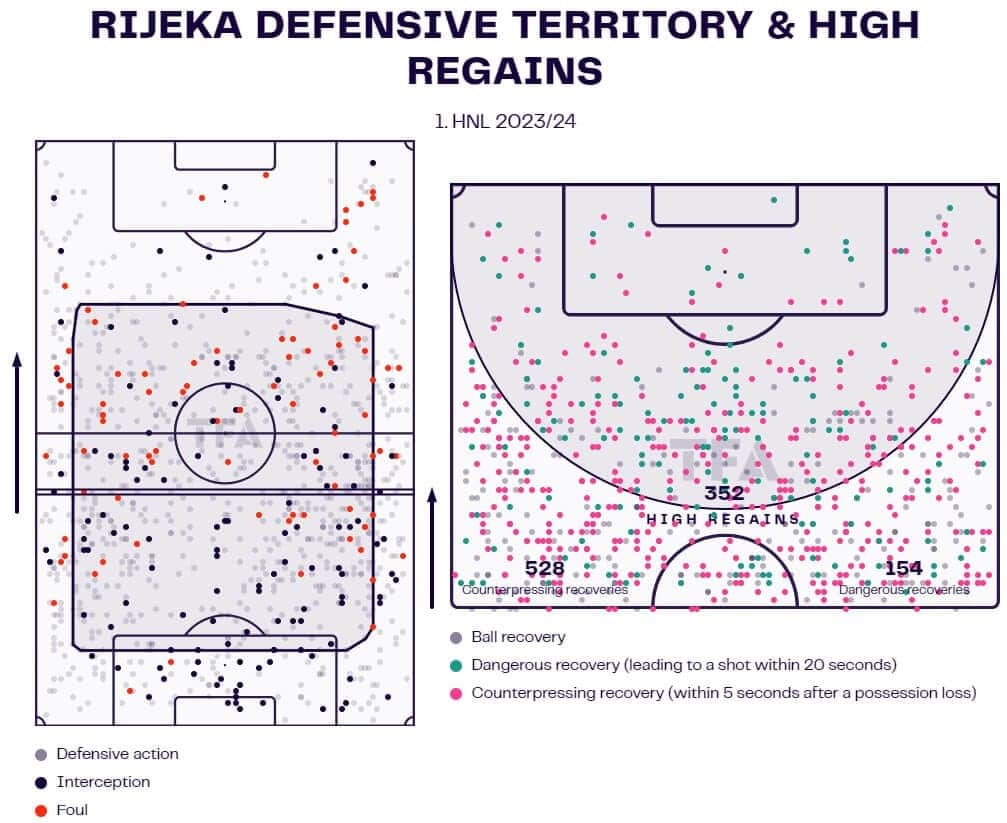
According to our database, they rank sixth in challenge intensity (rate of defensive actions) and have the fifth-highest PPDA number of all teams in the league, putting them right down the middle. In other words, they are not the most intense but are also far from being fully passive in their approach. Interestingly, too, they rank sixth and seventh in total defensive duels and interceptions, respectively, but they have the most among the Croatian big three.
One final thing to note here is the number of substitutions made, as Rijeka top this category and is the team that makes the most changes in games under Sopić this season. They are young and hungry, but they also still need to prove themselves worthy of being title contenders. Perhaps that’s also why the new coach keeps shuffling the cards to keep the team as fresh and as motivated as possible.
Conclusion
HNK Rijeka have had an incredible 2023/24 season so far and are on course to do the unthinkable and break the Dinamo Zagreb monopoly over the Croatian top division. That being said, we’re still far from the end, and the big three are all neck and neck. Historically, this has always been Dinamo’s competition, but if there were a year to crown a new king once more, it would be this one. Can Sopić truly make it? Time will tell.

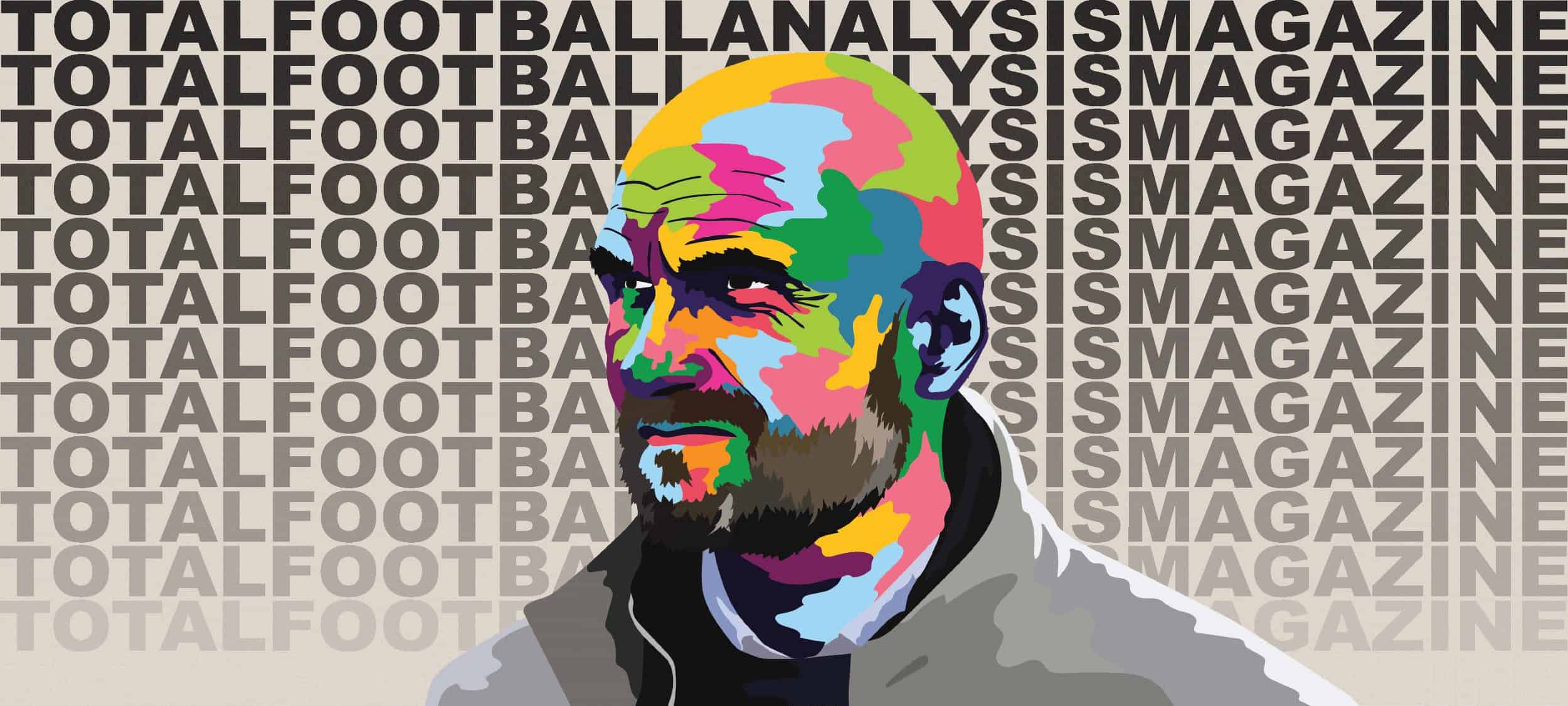




Comments